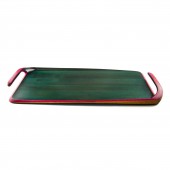NUi Superleggera Tray by Jaime Rosales |
Home > Winners > #67930 |
 |
|
||||
| DESIGN DETAILS | |||||
| DESIGN NAME: NUi Superleggera PRIMARY FUNCTION: Tray INSPIRATION: In those unassuming, ubiquitous, utilitarian products – seemingly undeserving of attention, let alone wonder, reside the most daunting design challenges. Arguably, the prosaic serving tray, is as drab as they get. Hence it was a compelling contender to find creative design solutions that would bring about noteworthy upgrades. So by pushing the bounds of wood, as a creative medium, an unprecedented level of versatility was attained to optimize each component for weight, structure and function. UNIQUE PROPERTIES / PROJECT DESCRIPTION: This ultra-light, minimalist, hardwood serving tray evolved via a reductionist approach to streamline each underlying parts to its essence. In turn, the functional imperatives focused on optimal structural integrity and weight transfer. So by virtue of ergonomics the cantilever handles confer an intuitive and seamless UX, while the rigidity of the framework boosts carrying capacity. The base design has a purpose-driven longitudinal arch, so that it rests on just 4 contact points; thus it can be comfortably placed on the lap and avoid surface humidity. OPERATION / FLOW / INTERACTION: This utilitarian serving tray design was developed to offer unparalleled usability and comfort. The weight profile was reduced by half, via 3D optimization and iterative prototyping. Naturally, this affords the user the ability to carry more, with less effort. Careful attention was given to how the load was distributed, in order to increasing the overall carrying capacity. Ergonomics informed every aspect of design, particularly the cantilever handles, to make the user experience enjoyable and safe. PROJECT DURATION AND LOCATION: Every phase of the development process from: conceptual design, prototyping, woodworking, to final finishing and assembly, was carried at our design studio on the outskirts of Managua, Nicaragua. The design concept was develop over the course of 2 weeks. The project was officially completed on July 24th 2017. FITS BEST INTO CATEGORY: Furniture Design |
PRODUCTION / REALIZATION TECHNOLOGY: The conceptual underpinnings of the design were defined on the basis of explicit functional and aesthetic criteria. It was critical to find simple solutions to the distinctive practical and functional advantages that were set forth. To do so, the entire design was iterated via 3D software and then prototyped extensively. Each part was optimized for manufacturability to ensure a seamless assembly process. Natural pigments were formulated to enhance the wood’s unique figure and iridescence. SPECIFICATIONS / TECHNICAL PROPERTIES: Tray Dimensions: 360 mm x 615 mm x 40 mm Product Weight: 880 grams Hardwood Species: Carapa guianensis Commercial Name: Andiroba Wood Stains: Natural Pigments Wood Finishing: Polyurethane TAGS: Serving Tray, Wood Tray, Hardwood Tray, Ultra-light Tray, Wood Utensil, Wood Kitchen Utensil, Kitchen Utensil, Utilitarian Design, Wood Design, Modern Serving Tray, Minimalist Serving Tray, Modern Tray, Minimalist Tray, Natural Pigment, Innovation, Organic Design, Eco-Friendly Wood Tray, Wood Decoration, Wood Centerpiece, Intuitive, User Experience, Ergonomic, Functionality, Aesthetics, 3D Design, Precious Wood, Eco Wood, Tropical Hardwood RESEARCH ABSTRACT: The goal was to determine the user pain-points and unmet needs, based on qualitative surveys, particularly as they relate to design, quality and materials. The user input was collected through one-on-one interviews, from a random sample of 140 users and observational analysis. The findings were predominantly focused on weight reduction, egronomics and the drawbacks of flat bottom designs. Trays were overwhelmingly used by households with a tendency to dine while watching TV. These insight informed handle design as well as the curved tray bottom. CHALLENGE: The bid was to strike a balance amid weight reduction and structural integrity. Curving the weight of each part without undermining it’s structural performance, is no easy feat. When every gram counts, each design feature has to be assessed on it’s impact to the overall weight profile. Aesthetically, the challenge was to seamlessly weave the design subtleties into a flowing silhouette, while inviting the eyes to unravel the simple, yet elegant symmetry. ADDED DATE: 2018-04-02 18:15:42 TEAM MEMBERS (18) : Designers:, Jaime Rosales, Mario Mendieta, Guillermo Martínez, , Master Craftsmen: , Guillermo Martínez , Ramiro Gaitán, , 3D Artist:, Erick Rugama, , Finishing Artist:, Wilbert Hernandez, , Sanding Artist:, Alejandro Guzmán and IMAGE CREDITS: Carlos Baez Castellón |
||||
| Visit the following page to learn more: http://www.nui.one | |||||
| AWARD DETAILS | |
 |
Nui Superleggera Tray by Jaime Rosales is Winner in Bakeware, Tableware, Drinkware and Cookware Design Category, 2017 - 2018.· Read the interview with designer Jaime Rosales for design NUi Superleggera here.· Press Members: Login or Register to request an exclusive interview with Jaime Rosales. · Click here to register inorder to view the profile and other works by Jaime Rosales. |
| SOCIAL |
| + Add to Likes / Favorites | Send to My Email | Comment | Testimonials | View Press-Release | Press Kit |
Did you like Jaime Rosales' Kitchenware Design?
You will most likely enjoy other award winning kitchenware design as well.
Click here to view more Award Winning Kitchenware Design.








